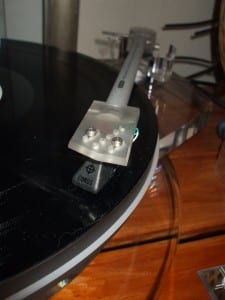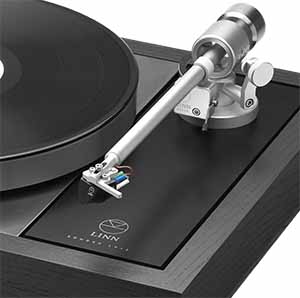My wife wandered into my music room and saw the recently unpacked turntable – “That’s very pretty, one of the best looking you’ve had” she said. I agree, it does look mighty fine.
The Radius 5.2 is a belt drive turntable and available in the clear acrylic that was delivered to me, or in black. The  turntable can be bought separately, but the one that was sent to me for review had a Nima unipivot arm already installed.
turntable can be bought separately, but the one that was sent to me for review had a Nima unipivot arm already installed.
Roksan is well known for its turntables and started in business back in 1985 to produce the original Xerxes turntable. The current range extends to the Xerxes.20 Plus, at £2,700 without arm. The entry level Radius 5.2, though, usually supplied with the Nima arm retails at a more affordable £1400 or so for the bundled package.
Roksan also produce a range of electronics and loudspeakers, and the Caspian M2 amplifier has been reviewed in Hifi Pig.
Setup
It was easy enough to set up the Radius 5.2, in principle, but I think the instructions could be improved, with better diagrams. A couple of times I found myself scratching my head and peering at the diagrams trying to figure out what should go where.
Here’s what you do …. Take the turntable with the arm already attached out of the box. Level it by adjusting the lockable screw-in feet. Remove the transit screw from the rear of the arm, insert the stub rod for attaching the counterweight and lock that in place using the aforementioned transit screw in a different threaded hole. Slide the counterweight onto the stub rod.
Place the platter onto the spindle.
Loop the belt around the platter and the drive motor – hmm, quite fiddly, I managed on the 3rd or 4th attempt; there’s  no groove for the belt on the platter rim and it tends to slide off. And it would be good if Roksan supplied some white cotton gloves for this to keep the belt clean and grease-free. I used a pair supplied with some Chinese hifi!
no groove for the belt on the platter rim and it tends to slide off. And it would be good if Roksan supplied some white cotton gloves for this to keep the belt clean and grease-free. I used a pair supplied with some Chinese hifi!
Attach your cartridge (nut/bolt set included).
There’s a clever locking mechanism for the Nima unipivot arm. Left to itself, the unipivot arm would wobble all over the place when being transported – not good! – but it is firmly secured by simply raising the arm by the pivot structure. Releasing it is just as easy, just firmly press it downwards. Cool.
I’ve a few complaints about the setup of the arm, but I guess you only have to do that once, unless you have a habit of changing cartridges.
Setting the tracking weight and azimuth accurately is very crudely done, to be honest, and is by no means a precision exercise. The counterweight is a push-on fit to the tonearm stub rod, and is held in place by a compliant rubber grommet inside the counterweight. The hole in the counterweight is offset from the centre, and azimuth is set by rotating the counterweight away from the vertical. As the arm is a unipivot, and so is supported only at a single point, the azimuth angle the arm sits at depends on the lateral forces applied – the offset cartridge twists it one way, so you have to twist the counterweight the other way by just the right amount to balance it out leaving the cartridge level with the platter. Similarly for the vertical tracking force (VTF); you have to slide – or rather, jerk – the counterweight back and forward until you happen to hit on the correct VTF. Given the compliant nature of the rubber grommet in the counterweight, this is a very hit and miss affair. Of course, once you rotate the counterweight to adjust the azimuth, it inevitably slides it along slightly and so changes the VTF. So you then adjust that by crudely wiggling the counterweight backwards or forwards and – what do you know! – the azimuth has changed a bit. … and round you go again!
Additional excitement was added for me, as my own cartridge does not have a cover to protect the stylus!
There are no graduation marks on the tonearm, it all has to be done by trial and error, with frequent VTF re-measurement. A simple but effective VTF measuring ‘seesaw’ balance is supplied.
So, setting up the arm & cartridge is a bit of an exercise in frustration, but you get there eventually. If you are used to the precision of a vernier based tonearm setup, this is a very different experience!
I have to confess that with my own Zu / Denon DL-103 cartridge, with its cuboid and massive aluminium body, I wasn’t able to balance the Nima tonearm without a little help from a small weight attached with blue-tac to the top of the Nima arm’s counterweight! This is perfectly usual with this monster of a cartridge in almost any tonearm and the issue won’t arise with most other cartridges; with the Corus Silver cartridge supplied by Roksan there wasn’t a problem at all.
So …. is it worth all this kerfuffle? …. YES !! …. read on ….
Sound Quality
Generalities ….
Light on its feet and musically engaging. Open and airy. Excellent pacing, and rhythms are readily latched on to. Bass is deep, with nice tautness and control, perhaps a little on the lean side of the fence although this is cartridge dependent.
Imaging is very well focussed and a real feel for the ambience of the recording is conveyed.
It’s hard not to enjoy the performance on offer!
One slight concern for a die-hard direct drive fan like myself, is that slight speed variations could be detected on sustained piano notes and sometimes on other material with slow decay, for example. I’m a fanatic when it comes to this, and I suspect very sensitive to the issue, and the effect was small but occasionally noticeable. But for the most part this did not intrude at all, and was not an issue with most music.
As I say, the imaging and soundstaging is good, but it is not quite on a par with the sophistication and believability of the Oracle Paris V turntable I previously reviewed for Hifi Pig. Mind you, the Paris V truly excelled in this regard and costs over twice as much as the Roksan package. And for sheer ‘boogie factor’ the Roksan gear gets the nod.
Specifics ….
Playing a gorgeous double LP of baroque works for solo lute with Eugen Dubois on the RCA / Seon label, the sound had a tactile immediacy and speed – with a nicely conveyed transient edge to the plucked strings. Nicely focussed, too, with excellent detailing, I really enjoyed this.
More classical music ensued, with an LP of French harpsichord music on the Turnabout label. Wonderfully lucid and very fast, the spang of the well recorded harpsichord was very nicely caught. Splendid, indeed.
Moving on to raunchier fare from Queen’s Greatest Hits, Another One Bites The Dust had a fantastically powerful and well controlled bass beat, and the vocals were exceptionally clear and incisive. It beat the CD I also have hands down for visceral impact and excitement! Wow, really fabulous.
Alice Cooper’s Billion Dollar Babies was a hoot, with vocals energetically presented and nicely focussed, and the backing band excitingly captured. Never the clearest of recordings, the upbeat nature of the Roksan brought out the best in the music.
Louis Armstrong’s raspy vocals and searing trumpet playing were grin-inducing on a RCA tribute double LP. It’s a beautifully mastered set, and well worth seeking out. The all-Roksan front end locked-on to the rhythms here, and the music really played to its strengths.
I couldn’t resist going back to classical music for my final listening session, and out came Bruckner’s 5th symphony on a magical Decca recording with Lorin Maazel conducting the Vienna Philharmonic.
Magnificent! – the ‘edge’ on massed violins was beautifully rendered, the brass fanfares echoing around the concert hall were awe-inspiring. A beautiful balance between resolution and ambience. You might have guessed by now that I really enjoyed this!
Cartridge Comparison
The Corus Silver moving magnet cartridge (£430) didn’t arrive for a few days, so I started off with my own Zu-DL103  moving coil cartridge (US$550), in its massive aluminium body. To be honest, I hadn’t expected this to be a good match with the Nima unipivot arm, but I was wrong there! It sounded very fine, and it’s slightly warm but effervescent and punchy character suited the Radius 5.2 / Nima very well.
moving coil cartridge (US$550), in its massive aluminium body. To be honest, I hadn’t expected this to be a good match with the Nima unipivot arm, but I was wrong there! It sounded very fine, and it’s slightly warm but effervescent and punchy character suited the Radius 5.2 / Nima very well.
The Corus Silver then arrived and was immediately installed. Off came the previously mentioned additional mass on the counterweight, needed to balance the tonearm with the massive Zu attached, the azimuth and tracking force were reset, the bias adjustment remained the same as both cartridges track at about the same weight (2 -2.3g).
The Corus Silver has a tad more detail and incisiveness, no doubt about it. It’s also a bit leaner and lighter weight in the bass. I usually find that moving coils do the 3D imaging thing better than moving magnets, and that was the case here as well. On  some material, though, the all-Roksan setup simply smoked the competing Zu and also CD – Queen’s Greatest Hits album is a fine example of this.
some material, though, the all-Roksan setup simply smoked the competing Zu and also CD – Queen’s Greatest Hits album is a fine example of this.
I enjoyed both the Corus Silver and the Zu DL-103 in the Roksan setup, both are very fine sounding if very different devices. If I had to decide between them, in my system and for my tastes I think I’d choose the extra weight and low end power of the Zu over the faster but lighter presentation of the Corus Silver; I found that Dire Straits’ Brothers In Arms album was more emotionally involving and the orchestral magnificence of the Bruckner symphony came over more powerfully, although the Queen album strongly reversed this preference! … so I can well imagine the decision going the other way for other listeners and other systems.
Conclusion
Setting the arm up is an approximate, trial and error affair, but once you have managed to wiggle the counterweight into correct alignment you don’t really have to worry about it again. And the slight speed stability issue will bother some listeners more than others.
The unipivot nature of the Nima arm may seem a bit strange and unusual to many folk, and it has a different feel to it than other types of arm. But in practice it is easy to use and seems happy with a heavy moving coil cartridge and with a lightweight moving magnet.
The Radius 5 mk2 turntable and Nima tonearm are a pleasure to use, a delight to look at in a minimalist modern kind of way, and the sound quality is very fine indeed.
Author – Jerry
____________________________
Review system: MBL 116F speakers, Krell KAV-250a power amp, Tisbury passive pre-amp, Trichord Dino / NCPSU & Eastern Electric MiniMax phonostages
Want to read more hifi reviews?

















































































































































































Great review Jerry, very informative and helpful tips for anyone looking to buy this TT
Excellent review Jerry. It’s almost exactly what I’ve found with this turntable. Excels in almost every way, stunning at times, but with that niggling fault of a bit of pitch instability on decaying piano or guitar notes. Not noticeable at all with rock, indie, dramatic classical etc.
Anyway for your (or anyone else who’s interested) info I have managed to get to the bottom of this. I’d tried cleaning the belt, then got a new belt, then renewed the bearing oil. Still the slight pitch instability. I then went to the length of ordering a new platter. The result? The pitch instability was now 10 times worse!!! What I noticed during this frustrating, not to say expensive, process was that the second platter I got was a lot looser fit on the spindle. It just sat on the spindle whereas my initial platter at least had to be given a bit of a push to get it stitting on properly and level. This led me to wonder if the pitch variation was due to the platter slipping on the spindle as it was rotating. I therefore put a ring of double sided sellotape around the inside of the platter-recess that the spindle goes into on the original platter. Problem solved. Pitch now perfectly stable.
A long journey, but hopefully it will help anyone out there with the same problem.
Amazing looking machine. Thanks for review.